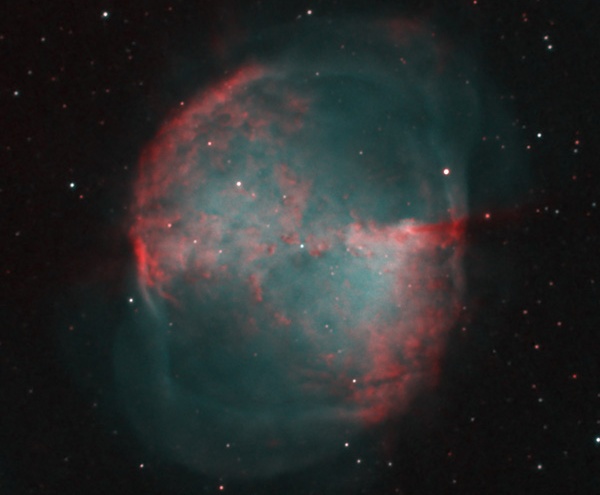Credit & Copyright: Rick Krejci
(RicksAstro Astrophotography)
Explanation:
While searching the skies above 18th century France for comets,
astronomer Charles Messier diligently recorded this object
as number 27 on his list of things which are
definitely not comets.
So what is it?
Well, 20th century astronomers would classify it as a
Planetary
Nebula ...
but it's not a planet either, even though it may
appear round
and planet-like in a small telescope.
Messier 27 (M27) is now
known to be an excellent example of a
gaseous emission nebula created
as a sun-like star runs out
of nuclear fuel in its core.
The nebula forms as the star's outer layers are expelled into
space, with a visible glow generated by atoms excited by the dying
star's intense but invisible
ultraviolet light.
Known by the popular name of the
Dumbbell
Nebula, the beautifully
symmetric interstellar gas cloud is about 1,200 light-years away in the
constellation
Vulpecula.
This intriguing
color composite
view was recorded through narrow band
filters sensitive to emission from hydrogen atoms (shown in red)
and oxygen atoms (shown in blue/green).
1999 2000 2001 2002 2003 2004 2005 2006 2007 2008 2009 2010 2011 2012 2013 2014 2015 2016 2017 2018 2019 2020 2021 2022 2023 2024 2025 |
Январь Февраль Март Апрель Май Июнь Июль Август Сентябрь Октябрь Ноябрь Декабрь |
NASA Web Site Statements, Warnings, and Disclaimers
NASA Official: Jay Norris. Specific rights apply.
A service of: LHEA at NASA / GSFC
& Michigan Tech. U.
|
Публикации с ключевыми словами:
planetary nebula - dumbbell nebula - Планетарная туманность - Эволюция звезд
Публикации со словами: planetary nebula - dumbbell nebula - Планетарная туманность - Эволюция звезд | |
См. также:
Все публикации на ту же тему >> | |
